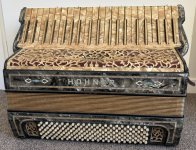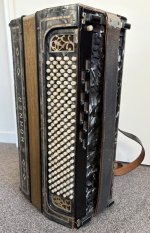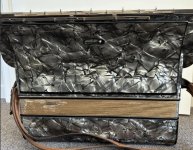MoreorlessMusic
Member
I was having a look at an auction website and saw this lovely Hohner listed. I am curious about the "extra" bass buttons. I keep counting eight rows rather than the usual 6, but maths was never my strong point!!! I wondered if any of you knew something about this model of accordion and what its age might be? I'm guessing 1920s or early 1930s, but I really have no idea.

Here is another view of the bass buttons. I wonder if the 7 slots with metal tabs that are below the air button are register selectors for the bass?

There are register selectors around the front, and slightly below the keyboard

What a beautiful looking instrument... and yes, I am a bit tempted!!

Here is another view of the bass buttons. I wonder if the 7 slots with metal tabs that are below the air button are register selectors for the bass?

There are register selectors around the front, and slightly below the keyboard

What a beautiful looking instrument... and yes, I am a bit tempted!!
